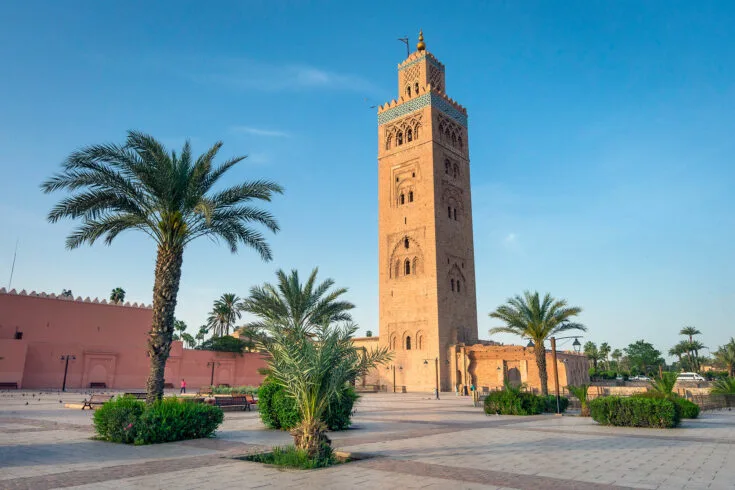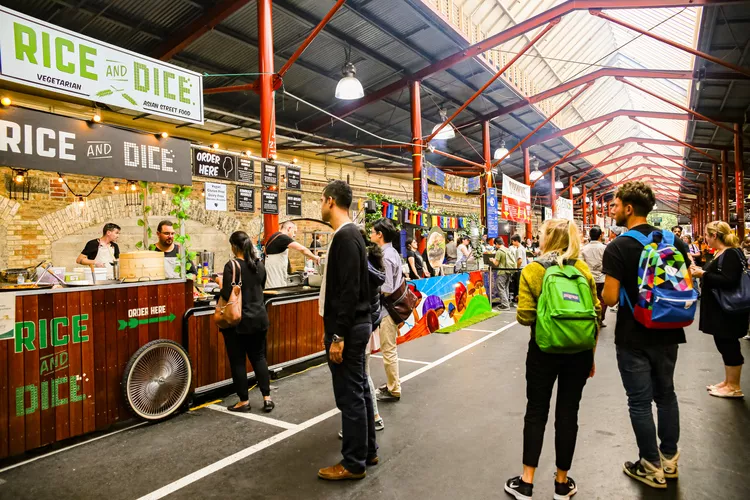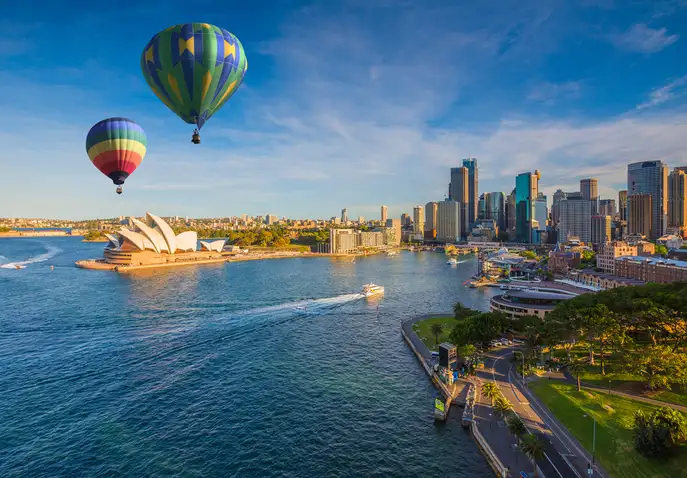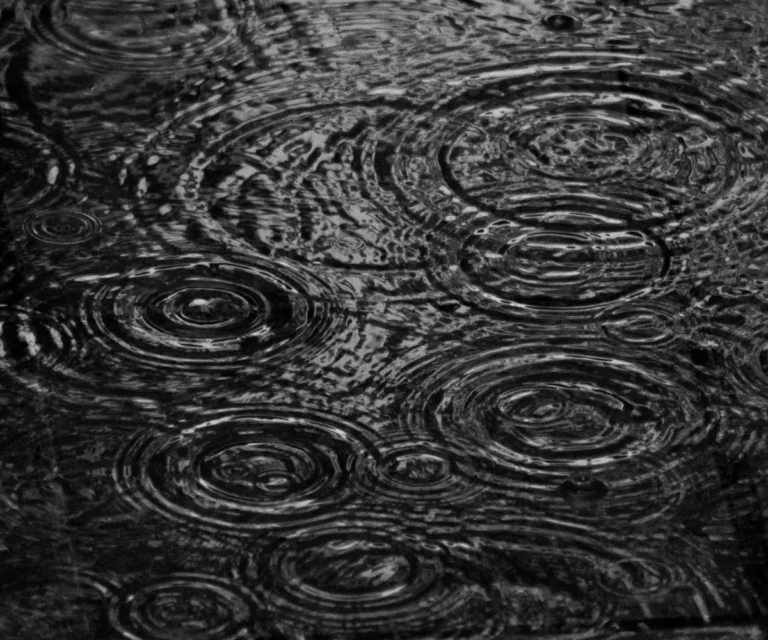Marrakesh, nestled in the heart of Morocco, captivates with its beauty. Often referred to as the “Rose City” or the “Red City,” it beckons visitors with a captivating blend of old-world charm and luxury. Discover the enchanting allure of Marrakesh through these top activities and experiences.
Many travelers exploring Morocco dedicate several days to the vibrant city of Marrakesh before venturing further into the country. Marrakesh, or Marrakech, is undeniably one of Northern Africa’s most captivating destinations. With a rich history as a significant trading center spanning centuries, the walled Old City Medina unfolds a labyrinth of bustling markets and a network of lively alleyways—a sensory delight.
Within this intricate tapestry, one encounters a symphony of smells, colors, flavors, sounds, and textures. While the bustling heart of the city can be simultaneously alluring and overwhelming, moments of serenity can be found in places like the riad hotels and various parks.
Beyond the enchanting chaos lie the city’s pulsating souks, theatrical street vendors, and mesmerizing performers—a spectacle in itself. Yet, the grandeur of palaces, the tranquility of mosques, and the culinary wonders should not be overlooked. Here are my top recommendations for the most rewarding experiences in Marrakesh.
Marrakesh Morocco Travel Guide
1. Exploring The Souks
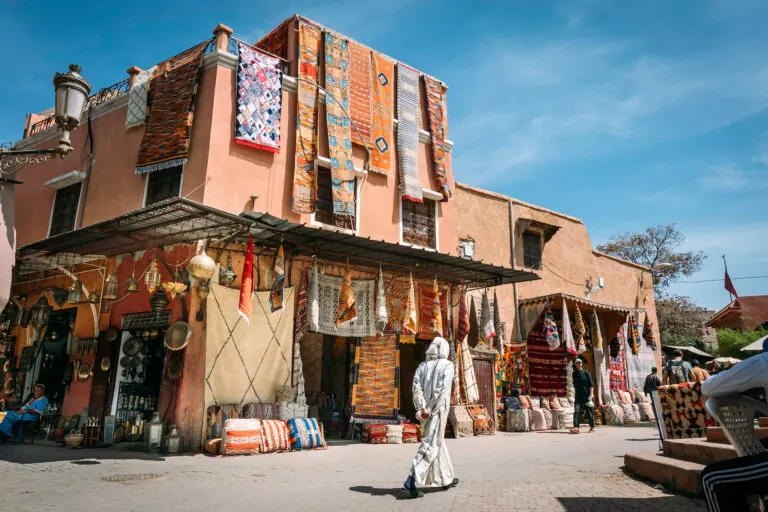
The Medina, Marrakesh’s enclosed Old Town, stands as the city’s premier tourist attraction—a complex network of narrow alleys adorned with shops, known as souks, offering a diverse range of goods, from fresh produce to Berber rugs and furniture.
Immersing yourself in the labyrinthine streets is a must, and I suggest savoring the experience: inhale the aromatic scents, admire the ancient architecture, peruse for souvenirs, and culminate your exploration with tea at one of the rooftop cafes, providing a unique vantage point to observe the vibrant hustle and bustle.
While the main souks, or markets, are concentrated in the heart of the Medina, such as Souk Semmarine, known for its popularity among tourists, venturing farther away unveils quieter realms, allowing you to escape the crowds. With over 3,000 market stalls, the seemingly endless maze of market streets may seem overwhelming, but fear not—getting lost is part of the enchantment of Marrakesh’s markets.
For those averse to the idea of navigating the intricate alleys and vast souks independently, consider opting for a tour with Star Vacations. This ensures you won’t lose your way, and guarantees you won’t miss any of the Medina’s must-see attractions.
“If you’re eager to plan this incredible tour, give us a call at +91 981-150-2655 to discuss your dream adventure: Talk to us!”
2. Jemaa el-Fnaa
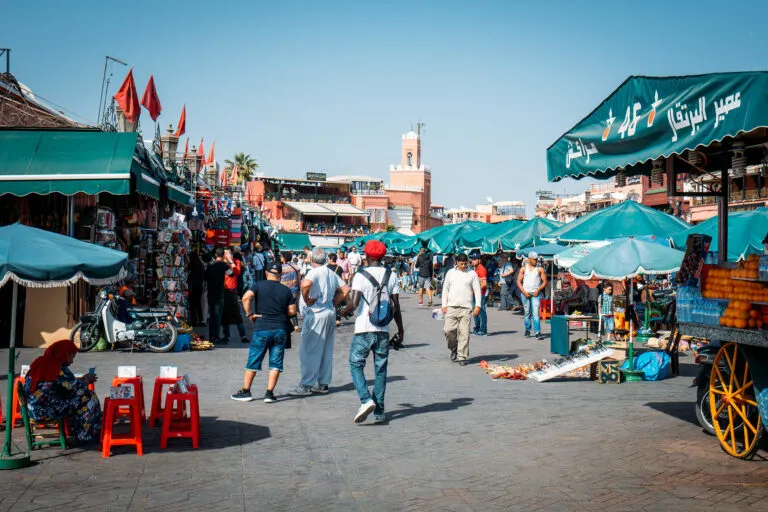
Jemaa el-Fnaa stands as the central square within Marrakesh’s Medina. Whether it’s day or night, the square pulsates with continuous street theater. Street food stalls, performers, and musicians create an ever-present spectacle, particularly vibrant after sunset.
Notably, the market on this square boasts the title of the busiest market in all of Africa. In 2001, UNESCO acknowledged its significance by designating Jemaa el-Fnaa as a World Heritage site. The square’s cultural richness even inspired UNESCO to establish a novel category: “Masterpieces of the Oral and Intangible Heritage of Humanity.”
Exploring Jemaa el-Fnaa during the day provides a different perspective, offering a less crowded and more tranquil atmosphere, allowing visitors to appreciate the square itself. However, returning at night unveils a transformed ambiance as Jemaa el-Fnaa truly comes alive. The evening showcases captivating performances by entertainers and musicians, enhancing the magical allure of this iconic square.
3. Koutoubia Mosque
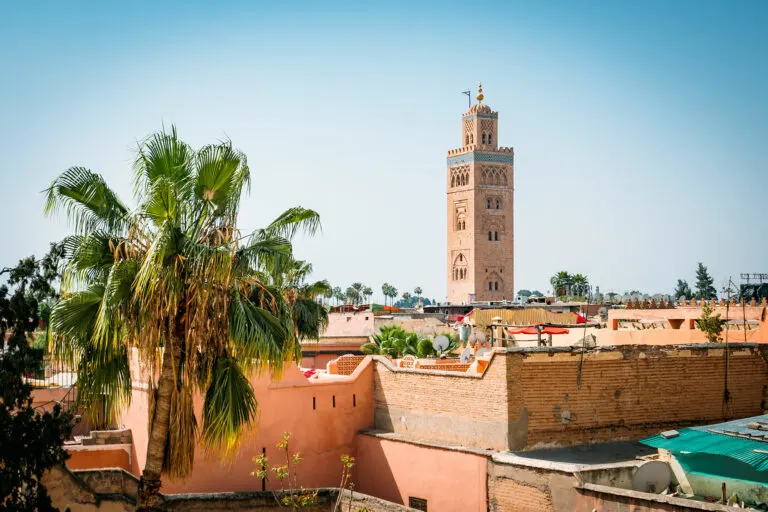
The Koutoubia Mosque, the largest mosque in Marrakech, commands attention and becomes an unmistakable part of the city’s skyline, even if you choose not to enter its premises.
As Marrakech’s most renowned landmark, the mosque’s towering minaret, standing at an impressive height of 250 feet (76 meters), gracefully dominates the cityscape, surpassing all other structures. The call to prayer, echoing from the muezzin’s voice five times a day, further ensures its pervasive presence.
While non-Muslims are restricted from exploring the mosque’s interior, the exterior and surrounding grounds offer a compelling visit, showcasing the exquisite Almohad architecture that defines this iconic structure.
“If you’re eager to plan this incredible tour, give us a call at +91 981-150-2655 to discuss your dream adventure: Talk to us!”
4. Stay In A Traditional Riad
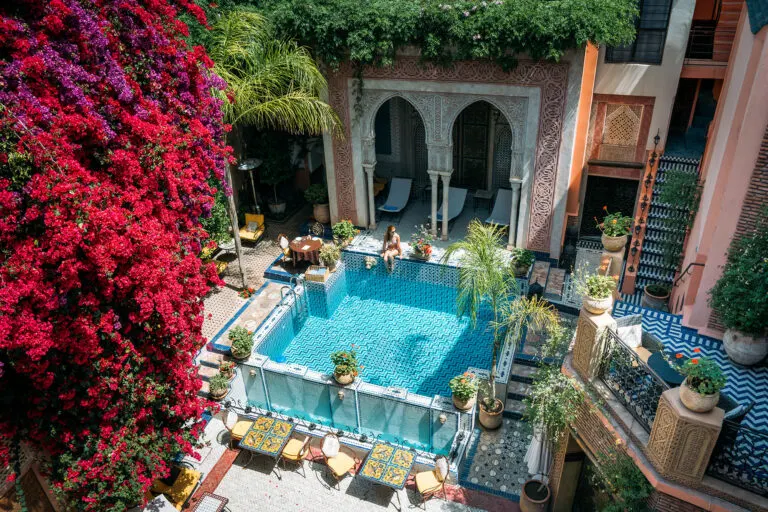
Immersing yourself in a riad, a traditional Moroccan guesthouse, promises an indelible experience that unveils the intricate beauty of Moroccan architecture.
A riad is essentially a mansion arranged around a petite swimming pool within a courtyard adorned with lush greenery, creating a serene oasis within the lively city. The ambiance of riads, marked by their intricate decorations and adherence to traditional architectural styles, stands as a truly distinctive and unparalleled experience amidst the vibrancy of the surroundings.
5. Eat Traditional Moroccan Food
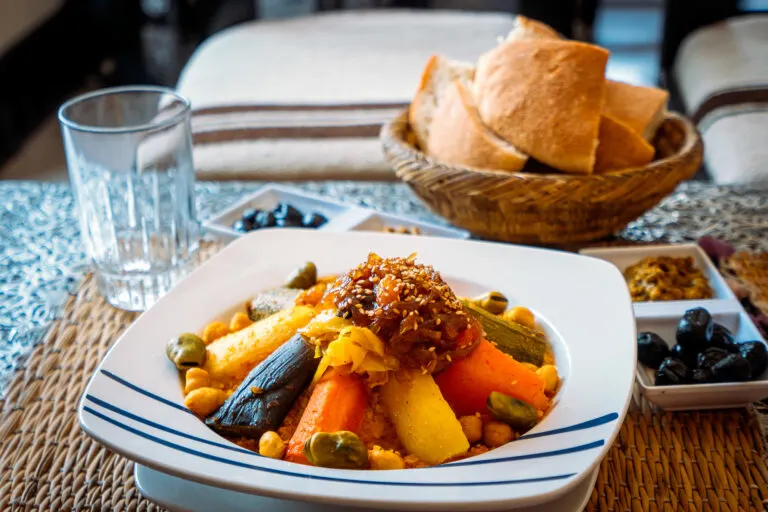
Moroccan cuisine derives its rich flavors from a fusion of Berber, Jewish, Arab, Mediterranean, and French culinary influences, with subtle notes of European and sub-Saharan inspiration. The gastronomy of Morocco boasts a delightful combination of savory, sweet, and sour tastes, expertly seasoned with a myriad of spices.
- Tangia: Slow-cooked lamb with lemon, garlic, and saffron, prepared in a clay pot over charcoal.
- Tagine: A savory slow-cooked stew featuring lamb, chicken, or fish, paired with vegetables, nuts, and dried fruit, served in the characteristic clay pot.
- Couscous: A delightful dish made from processed durum wheat semolina, served with vegetables and meat.
- Bastilla: A Moroccan chicken pie with layers of saffron-infused chicken, a spicy omelet filling, and crunchy fried seasoned almonds encased in a crispy pastry shell.
- Taktouka: A zesty puree of tomatoes and green peppers.
- Zaalouk: A dip made with eggplant, fresh tomatoes, garlic, olive oil, and spices like cumin, paprika, parsley, and fresh cilantro.
- Shakshouka: A popular Mediterranean breakfast dish where eggs are cooked in a tomato sauce with peppers, garlic, onions, olive oil, and spices.
- Harira: A tomato-based soup featuring lentils and chickpeas.
- Fish Chermoula: A herb sauce used to marinate grilled fish.
Exploring Marrakech’s culinary scene can be overwhelming with its myriad of restaurants. Here are some noteworthy places to savor these delights:
Mechoui Alley: For the best slow-cooked lamb, witness local families roasting whole lamb or mutton in an underground oven for an authentic experience.
Café des Épices: Located on the edge of Rahba Kedima Square, it’s an excellent spot for a traditional Moroccan breakfast.
Atay Café (62 Rue Amsafah): Ideal for trying various tajine dishes, including chicken, kefta (meatball), or lamb. They also offer vegan tajine and couscous.
Café Clock (224 Derb Chtouka): A fantastic place to sample a variety of traditional Moroccan dishes.
Nomad (1 Derb Aarjane): A popular rooftop restaurant offering scrumptious Moroccan food, including tajine, lamb, fish, and a vegetarian platter.
Don’t miss the chance to enjoy the ubiquitous Moroccan mint tea, a delightful experience for both tea enthusiasts and non-tea drinkers alike. Head to the terrace of Café De France (Rue des Banques), overlooking Jemaa el-Fnaa, for a perfect cup of mint tea.
“If you’re eager to plan this incredible tour, give us a call at +91 981-150-2655 to discuss your dream adventure: Talk to us!”
6. Visit A Tannery (at your own risk)
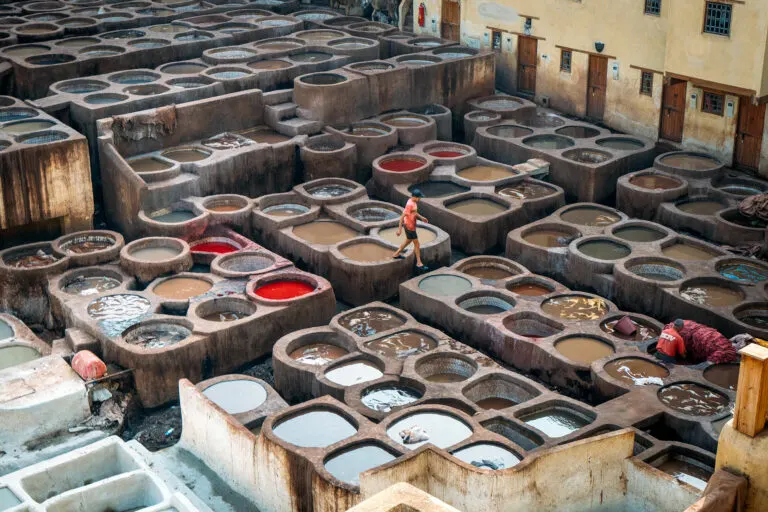
Bab Debbagh, located in Marrakech, is renowned for its numerous tanneries, showcasing the ancient craft of leather tanning—one of Morocco’s oldest traditions. Observing the skilled leather-makers at work adds a profound appreciation for any leather goods you might consider purchasing.
Here, the leather is meticulously treated and dyed using time-honored techniques, and the vibrant tannery pools offer a captivating visual spectacle. For the most immersive experience, I recommend visiting the tanneries early in the morning when the majority of the work takes place. The rooftops of surrounding shops provide the best vantage points for capturing striking photos.
While exploring, you can also peruse and purchase a variety of leather goods, including bags, jackets, leather poufs, and traditional babouches (Moroccan slippers). However, it’s essential to be adept at haggling during your transactions.
Crucially, exercise caution and avoid attempting to visit the tanneries independently. Unscrupulous individuals posing as local guides often exploit and harass unsuspecting tourists, attempting to extort excessive sums of money. The area can also pose safety risks and be challenging to navigate. To explore this intriguing part of the city, it is advisable to arrange an official group or private tour through your hotel in advance.
7. Dar El Bacha Palace (Musee Des Confluences)
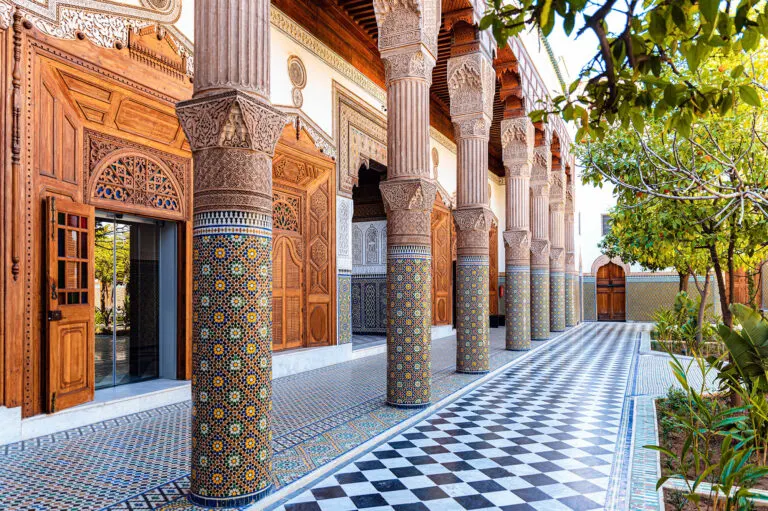
Discover the allure of riad architecture adorned with exquisite Zellige tiles, a distinctive Moroccan geometric tilework, at Dar El Bacha Palace—an exceptional destination showcasing the beauty of early 20th-century design.
Commissioned for Thami El Glaoui, the Pasha of Marrakesh from 1912 to 1956, Dar El Bacha Palace beckons with its remarkable interior aesthetics, Moorish decorations, and a meticulously arranged courtyard. Beyond its captivating architecture, the palace hosts dynamic art exhibitions, providing a cultural dimension to your visit. Additionally, a well-preserved Hammam (Moroccan bathhouse) offers a glimpse into traditional bathing rituals.
Coffee enthusiasts will find a delightful retreat in the palace’s chic coffee house, Bacha Coffee. While it leans towards the pricier side, the opulent interior, coupled with specialty coffees and delectable French baked goods, justifies the indulgence. (Please note that the opening times coincide with those of the museum.) Dar El Bacha Palace offers an immersive experience, inviting you to appreciate both its historical grandeur and contemporary cultural offerings.
Location: Rue Lalla Fatima Zahra
Operating Hours: 10 am – 6 pm; Closed on Tuesdays
Entrance Fee: Dh60 for adults (approximately US$6); Children enter for free.
“If you’re eager to plan this incredible tour, give us a call at +91 981-150-2655 to discuss your dream adventure: Talk to us!”
8. Bahia Palace
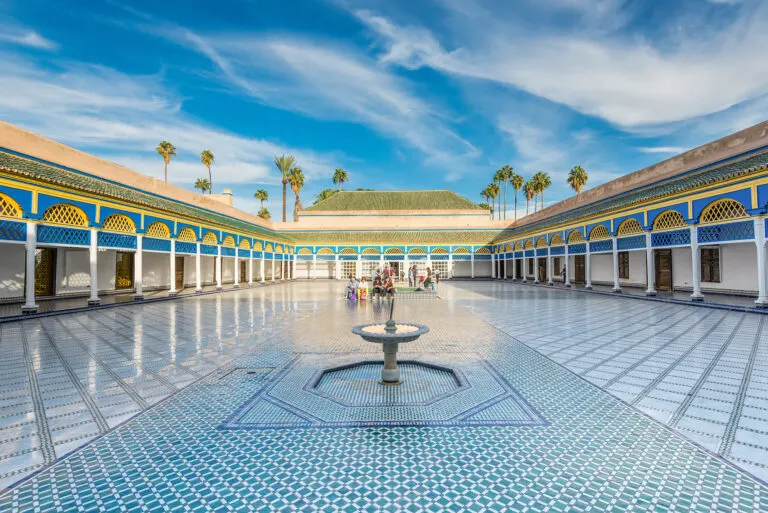
Explore the captivating architecture of Morocco, infused with Moorish and Andalusian influences, at Bahia Palace—an exquisite testament to the country’s design aesthetics.
Dating back to the 1860s, this palace boasts 150 rooms and numerous courtyards adorned with marble floors, adorned with fragrant orange trees and charming fountains. Wander through the opulent spaces, adorned with impressive tile art, intricate mosaics, muqarnas, arabesques, and stucco intricately carved with Arabic inscriptions.
For architecture enthusiasts, a visit to Bahia Palace is a must, especially considering its near-free accessibility. To fully appreciate the experience, it’s advisable to arrive early, as the palace tends to attract larger crowds later in the day. Don’t miss the chance to immerse yourself in the enchanting beauty of Bahia Palace, a gem in Morocco’s architectural heritage.
The azure hues of the tiles in this place brought to mind another beloved Moroccan city of mine—the enchanting blue city of Chefchaouen.
Address: Rue Riad Zitoun el Jdid
Operating Hours: Daily from 9 am to 5 pm
Entrance Fee: Dh10 (approximately US$1)
9. Badii Palace
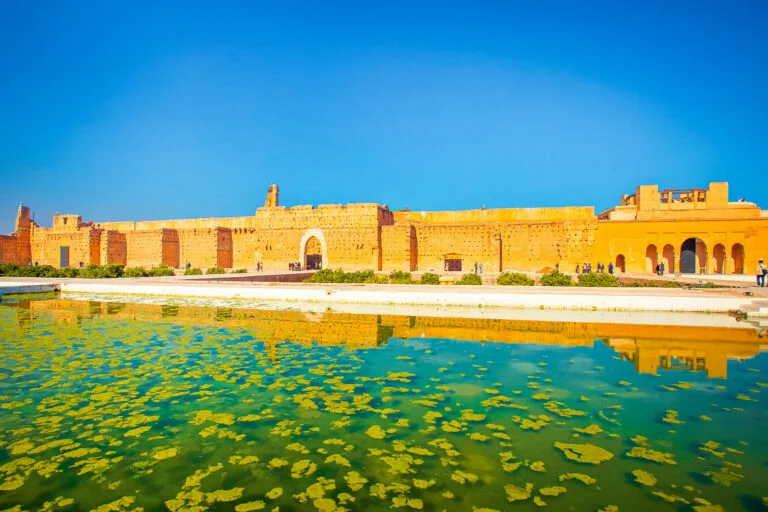
The third magnificent palace in Marrakech is Badii Palace, also known as El Badii-Ksibat Nhass Palace, constructed in the 1570s. Translating to “The Incomparable Palace,” it was once a resplendent edifice boasting over 350 luxurious rooms. However, today, only the weathered sandstone shell of the palace remains.
Despite its diminished state, there are still noteworthy intact features that render a visit to the ruins worthwhile. These include four sunken orange orchards with an empty reflection pool, floor mosaics in certain rooms, and a collection of artifacts and original pieces of art, providing glimpses into the palace’s former grandeur.
Address: Ksibat Nhass
Operating Hours: 9 am – 5 pm; CLOSED on Saturdays
Entrance Fee: Dh10 (approximately US$1)
“If you’re eager to plan this incredible tour, give us a call at +91 981-150-2655 to discuss your dream adventure: Talk to us!”
10. Saadian Tombs
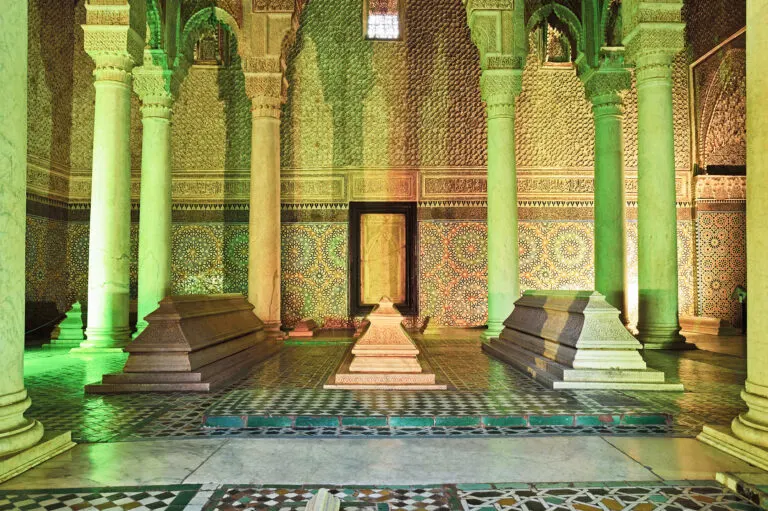
The Saadian Tombs form a regal necropolis established during the 16th century Saadian dynasty, encompassing approximately 170 mausoleums and tombs.
Ahmed el-Mansour, who reigned from 1578 to 1603, constructed the most opulent mausoleum, known as the Hall of Twelve Columns, serving as his final resting place. Within this remarkable site, 66 princes and other distinguished figures find their resting place, alongside more than a hundred chancellors and their spouses.
The exquisite classic Moroccan architecture and intricate design details on display include Italian Carrara marble, elaborate wood carvings, stunning tile mosaics, domed ceilings, and honeycomb plasterwork adorned with gold gilding. This site stands as a testament to the artistic prowess of the Saadian era.
Address: The Saadian Tombs are situated along Rue de la Kasbah on the south side of the Kasbah Mosque, in close proximity to El Badi Palace.
Operating Hours: Open every day from 9 am to 5 pm.
Entrance Fee: Dh70 (approximately US$7)
11. Jardin Majorelle
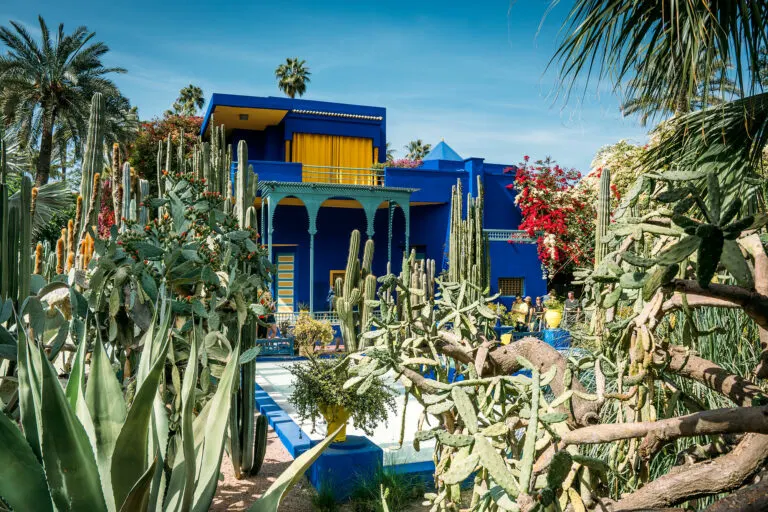
Jardin Majorelle stands as Marrakech’s most vibrant botanical haven, encircling a strikingly brilliant blue structure and showcasing a diverse array of plant life, including cacti, palm trees, and bamboo. Originally conceived by French painter Jacques Majorelle, the gardens later became the joint possession of fashion icon Yves Saint Laurent and his business partner Pierre Bergé.
Amidst the lush vegetation, visitors can marvel at Moorish-style archways, vivid tile art, as well as enchanting fountains and pools. The site also features a modest museum, offering insights into YSL’s deep connection with Marrakech—highlighted by the scattering of his ashes in the rose garden of Jardin Majorelle upon his passing in 2008. Fashion enthusiasts with an inclination towards haute couture may find the museum particularly intriguing.
A noteworthy detail is the distinctive shade of blue that coats the house, a hue crafted by Jaques Majorelle himself and recognized as “Majorelle Blue.” Allocate approximately an hour for exploring the gardens, or extend your visit to at least 90 minutes if you wish to delve into the YSL museum as well.
Address: Jardin Majorelle is situated on Rue Yves St Laurent.
Operating Hours: Open daily from 8 am to 6:30 pm.
Entrance Fee: Dh70 (approximately US$7). The museum has an additional admission cost of Dh30 (US$3).
“If you’re eager to plan this incredible tour, give us a call at +91 981-150-2655 to discuss your dream adventure: Talk to us!”
12. Ben Youssef Madrasa
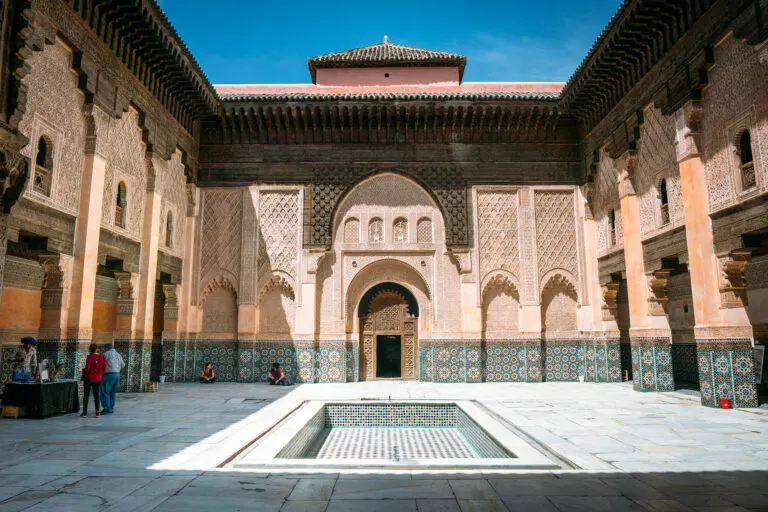
Constructed in the 14th century, Ben Youssef Madrasa once stood as the largest Islamic college in Morocco, accommodating up to 900 students. Today, this historical site is revered for its breathtaking architecture and Islamic design, earning it the distinction of being one of the most exquisite buildings in the entire country.
The artistic craftsmanship of this former educational institution is nothing short of remarkable. From a stunning marble-tiled patio featuring a reflection pool to intricate mosaic tilework, stuccoes, latticed balconies, and a grand bronze doorway, every element speaks to the beauty of Islamic design. Many of these ornate details were added during the Saadian dynasty, contributing to its status as the most extravagant Islamic college in Northern Africa. A visit to Ben Youssef Madrasa offers a journey into the splendor of Moroccan architectural heritage.
Address: Rue Assouel
Operating Hours: Daily from 9 am to 6 pm
Entrance Fee: Dh50 (approximately US$5)
13. Heritage Museum Marrakesh
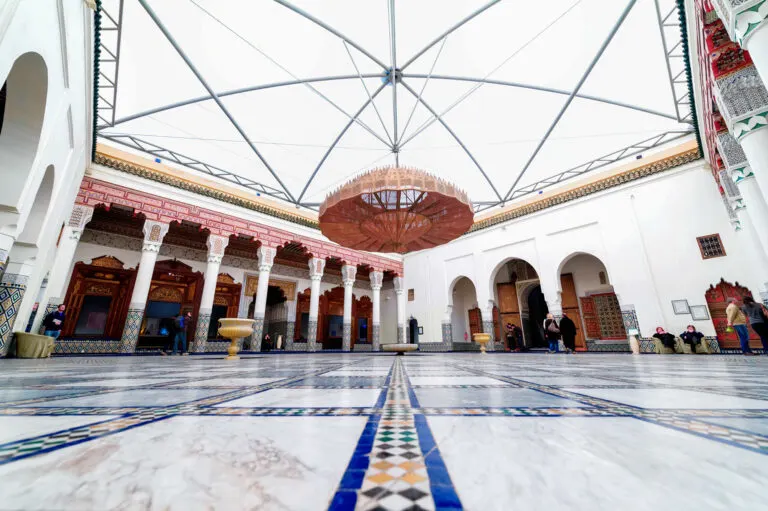
Situated in the heart of the Medina, a brief stroll from Jemaa el-Fnaa, the quaint Heritage Museum (Musée de Marrakech) occupies a 17th-century riad. Inside, it exhibits a collection of Moroccan antique artifacts amassed by the Alouani Bibi family. The intriguing assortment encompasses everything from jewelry to traditional Berber costumes.
Pro Tip: Don’t miss the rooftop café, offering fantastic panoramic views of the Medina. The Heritage Museum is a worthwhile visit, and the stunning views from the rooftop alone make it a memorable experience!
Address: 25 Zinkat Rahba
Operating Hours: Daily from 9 am to 6 pm
Entrance Fee: Adults – Dh50 (approximately US$5) / Children – Dh20 (around US$2)
“If you’re eager to plan this incredible tour, give us a call at +91 981-150-2655 to discuss your dream adventure: Talk to us!”
14. Le Jardin Secret
Le Jardin Secret, meaning Secret Garden, is an enchanting oasis nestled within a small riad in the heart of the Medina. With origins tracing back over 400 years to the Saadian dynasty, this garden is a testament to Moroccan heritage.
Designed as a traditional Islamic garden, Le Jardin Secret captivates visitors with exquisite Moroccan architecture and tile art. The expansive garden, surprisingly spacious, unfolds like a concealed sanctuary within the bustling Medina—an ideal refuge to escape the noise and crowds and revel in the serenity of nature.
Beyond the garden’s allure, the complex features a small museum, a boutique, and two cafes. The tower within the premises stands as the second-highest in Marrakesh, offering breathtaking views, including a glimpse of the Atlas Mountains on clear days. For those seeking elevated perspectives and remarkable photo opportunities of Marrakech, the additional 30 Dirham (US$3) to ascend to the top of the tower is a worthwhile investment.
Address: 121 Rue Mouassine
Operating Hours: Daily; March to September: 9:30 am – 7:30 pm, February to October: 9:30 am – 6:30 pm
Entrance Fee: Adults – Dh80 (approximately US$8) / Children under 6 – Free
15. Visit A Hammam
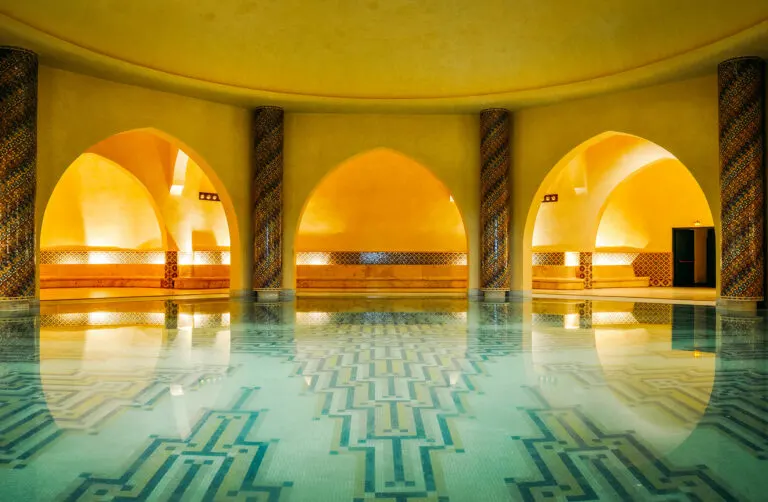
Embarking on a journey to a Hammam, a traditional Moroccan bathhouse, is an essential Moroccan experience, particularly appealing to spa enthusiasts. The Berbers have honed their body-cleansing rituals for millennia, offering a rejuvenating scrub-down with beauty products infused with Moroccan argan oil and Moroccan black soap.
Indulging in a Moroccan massage during your Hammam visit is an option, but it’s important to note that these massages typically involve more vigorous scrubbing compared to conventional massages.
Beyond the therapeutic treatments, the antique hammams themselves are architectural gems worth exploring. Characterized by high domes, star-shaped vents, and stone-paved or marble steam rooms, these spaces evoke simplicity and historical charm.
Hammam Dar el-Bacha stands out as the largest public hammam in Marrakech, yet the city boasts numerous hammams catering to tourists, each offering a unique and immersive experience.
Address: 20 Rue Lalla Fatima Zahra
Operating Hours: Daily, with distinct entrance times for men and women. Men: 7 am to 1 pm; Women: 1 pm to 9 pm
Entrance Fee: Dh10 (approximately US$1)
“If you’re eager to plan this incredible tour, give us a call at +91 981-150-2655 to discuss your dream adventure: Talk to us!”
Additional Hammams in Marrakech
- Royal Mansour (Rue Abou Abbas El Sebti) – Owned by the King of Morocco
- Hammam Mouassine (Rue Sidi el Yamani) – Marrakech’s Oldest Hammam
- Hammam de la Rose (Route Sidi Abdelaziz) – A Beautiful, Elaborately Decorated Spa
- La Mamounia Spa (Avenue Bab Jdid) – A Lavish Hammam in a 5-Star Hotel
- Les Bains de Marrakech (2 Derb Sedra)
- Hammam Rosa Bonheur’s (35 Derb El aarssa)
- Le Bain Bleu (32 Derb Chorfa Lakbir)
- Heritage Spa (40 Arset Aouzal Rd)
- Price: Most hammams in the Old City range from USD $10 to USD $30.
Also Read
